Abstract
The purpose of this study was to determine whether or not caffeine would exacerbate renovascular hypertension. Therefore, we examined the effects of chronic caffeine administration on arterial blood pressure in rats subjected to either unilateral renal artery clipping (2K-1C rats) or sham-operation. Animals in each group were randomly assigned to receive either 0.1% caffeine in their drinking water or normal drinking water, and systolic blood pressure was monitored for 6 wk. Caffeine markedly exacerbated the severity of hypertension in 2K-1C rats and caused histological changes consistent with malignant hypertension. 6 wk after surgery, systolic blood pressure, plasma renin activity, and creatinine clearance in control 2K-1C rats were 169 +/- 5 mmHg (mean +/- SEM), 4.4 +/- 0.5 ng AI X ml-1 X h-1, and 2.9 +/- 0.2 ml/min, respectively; as compared with 219 +/- 4 mmHg, 31.8 +/- 7.8 ng AI X ml-1 X h-1, and 1.4 +/- 0.3 ml/min, respectively, in 2K-1C rats receiving caffeine (all values were significantly different compared with control 2K-1C). Chronic caffeine administration did not alter systolic blood pressure, plasma renin activity, or creatinine clearance in sham-operated rats or spontaneously hypertensive rats. Chronic treatment with enalapril (a converting enzyme inhibitor) prevented the development of hypertension in control 2K-1C rats and caffeine-treated 2K-1C rats; however, withdrawal of enalapril precipitated a rapid rise in systolic blood pressure in caffeine-treated 2K-1C rats, but not in control 2K-1C rats. These experiments indicate that caffeine specifically exacerbates experimental renovascular hypertension and might worsen the hypertensive process in patients with renovascular hypertension.
Full text
PDF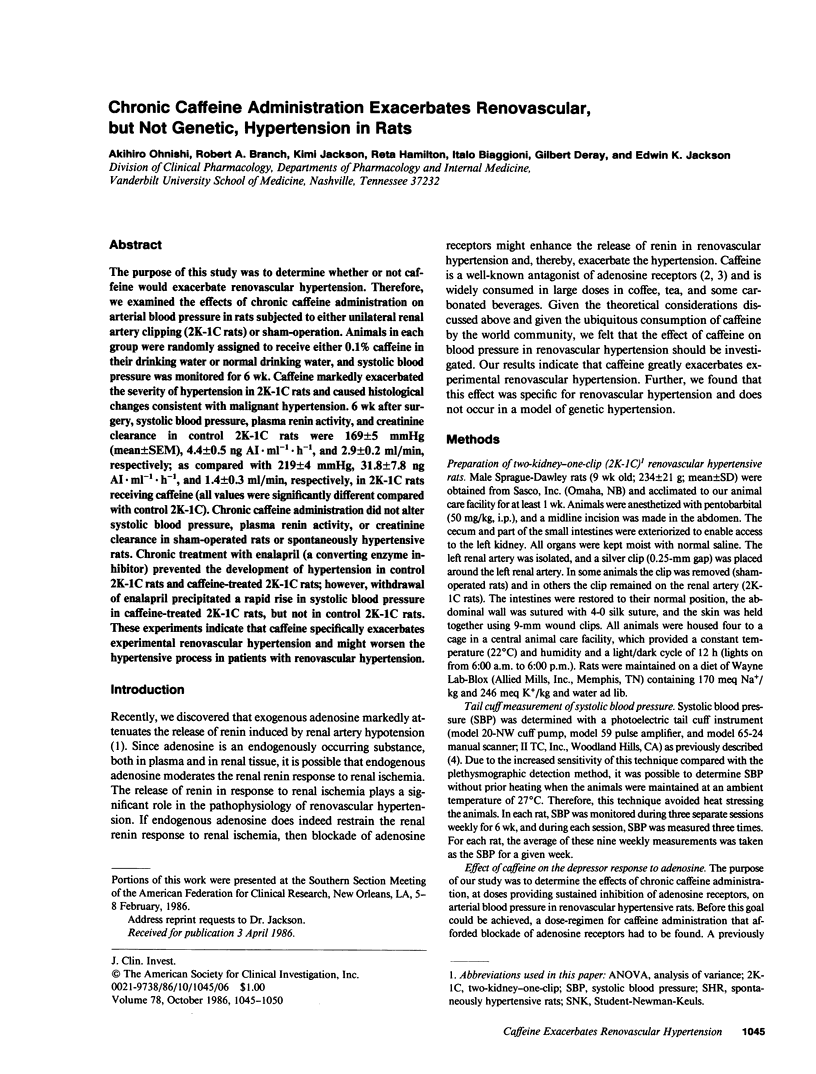
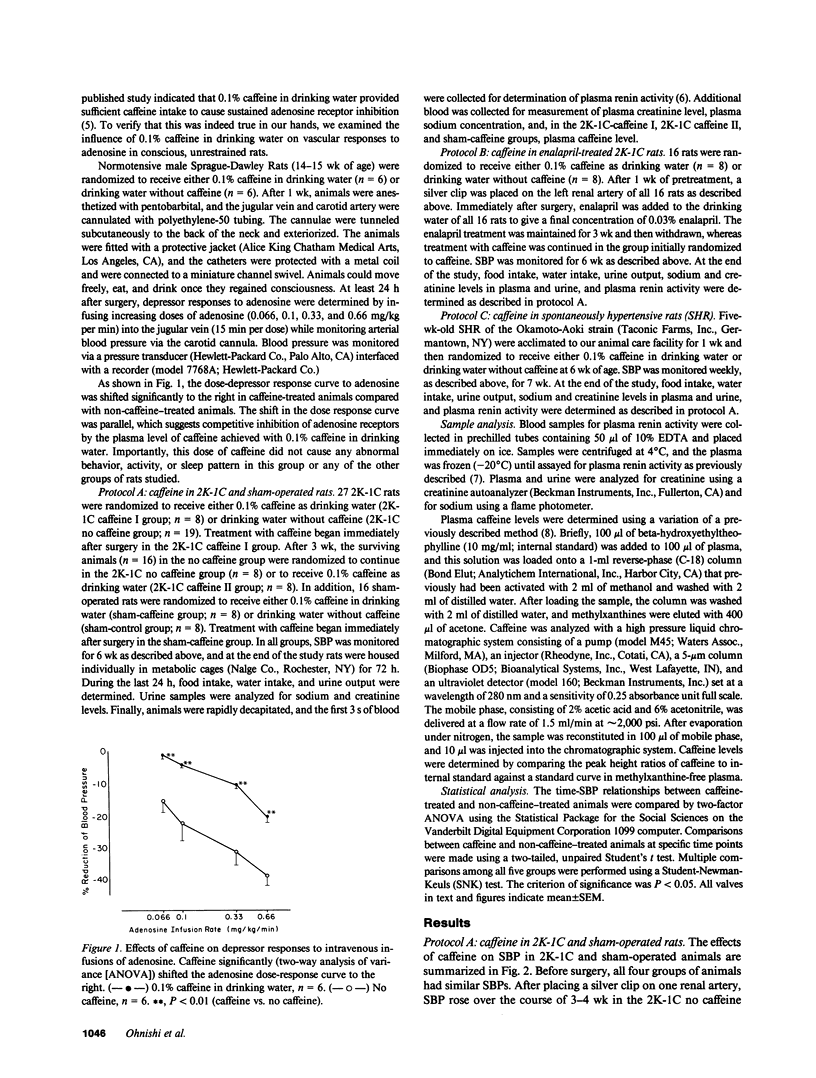
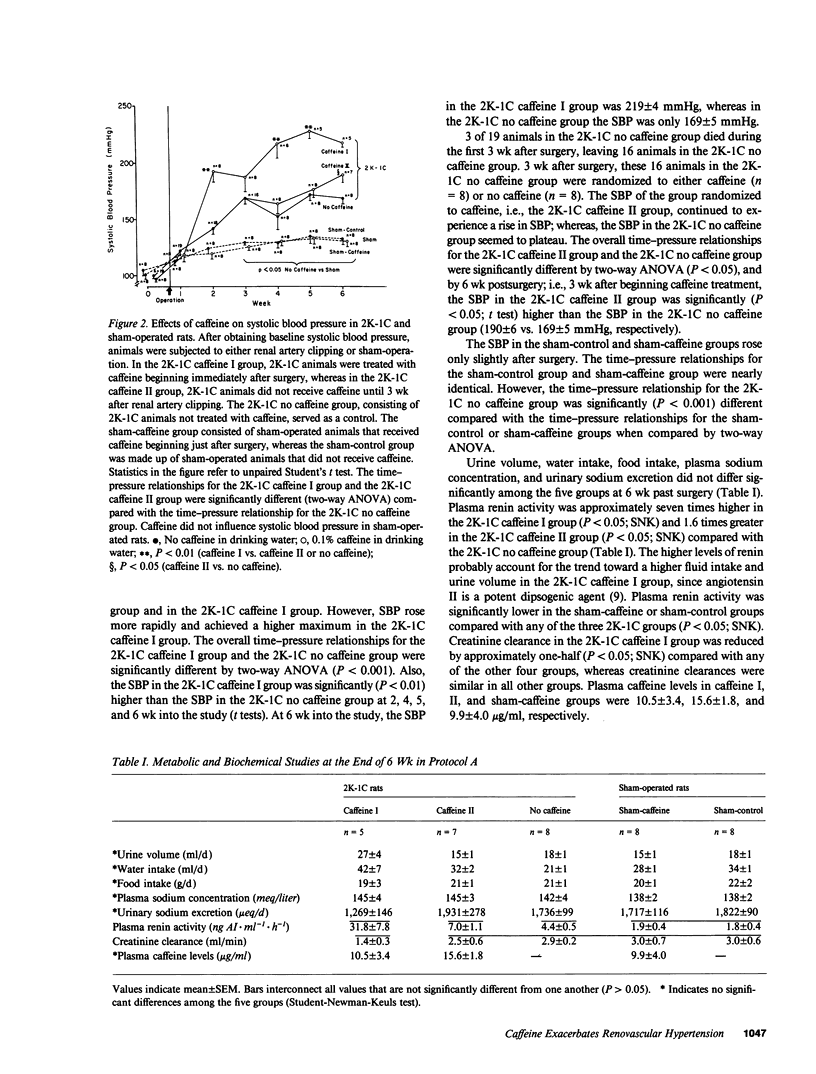

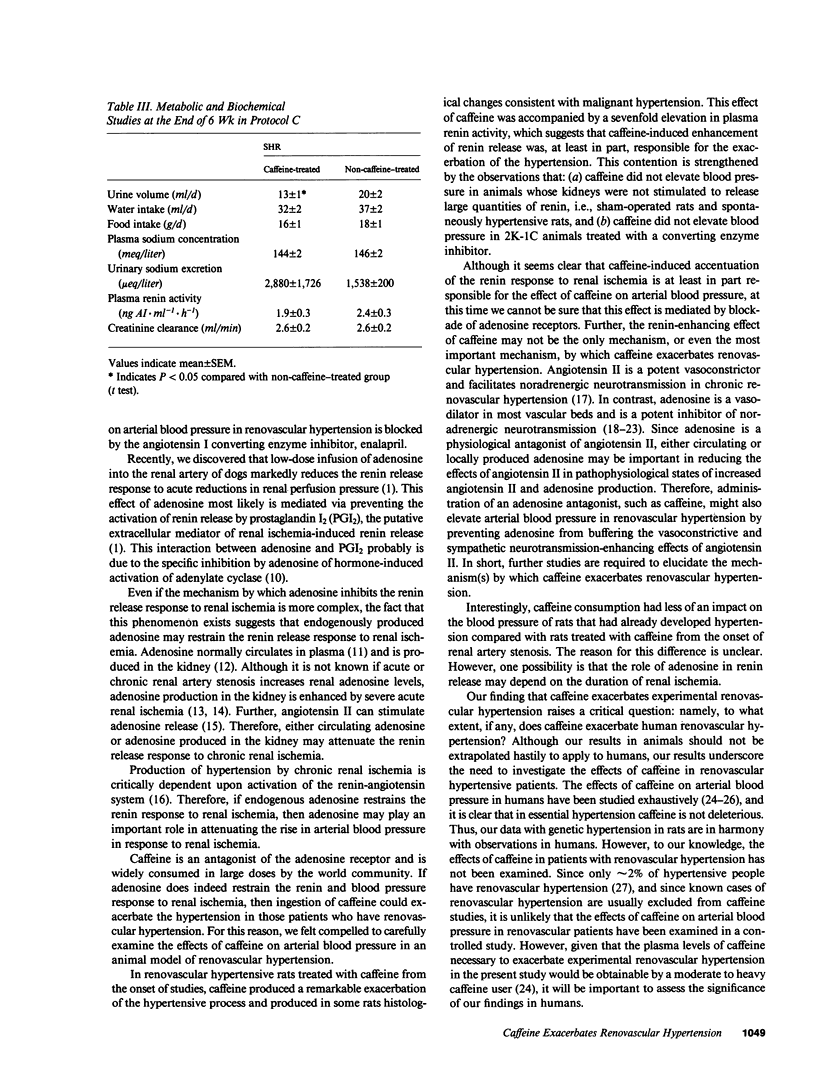
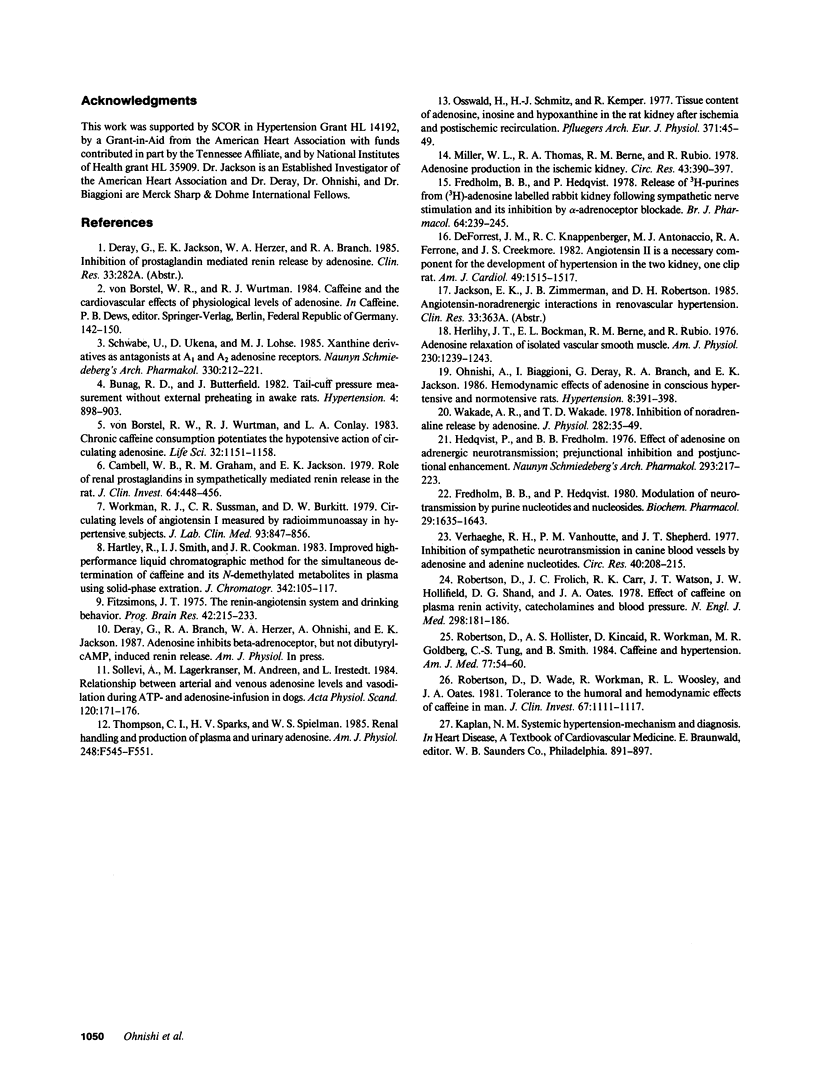
Selected References
These references are in PubMed. This may not be the complete list of references from this article.
- Buñag R. D., Butterfield J. Tail-cuff blood pressure measurement without external preheating in awake rats. Hypertension. 1982 Nov-Dec;4(6):898–903. doi: 10.1161/01.hyp.4.6.898. [DOI] [PubMed] [Google Scholar]
- Campbell W. B., Graham R. M., Jackson E. K. Role of renal prostaglandins in sympathetically mediated renin relase in the rat. J Clin Invest. 1979 Aug;64(2):448–456. doi: 10.1172/JCI109482. [DOI] [PMC free article] [PubMed] [Google Scholar]
- DeForrest J. M., Knappenberger R. C., Antonaccio M. J., Ferrone R. A., Creekmore J. S. Angiotensin II is a necessary component for the development of hypertension in the two kidney, one clip rat. Am J Cardiol. 1982 Apr 21;49(6):1515–1517. doi: 10.1016/0002-9149(82)90373-3. [DOI] [PubMed] [Google Scholar]
- Fitzsimons J. T. The renin-angiotensin system and drinking behavior. Prog Brain Res. 1975;42:215–233. doi: 10.1016/S0079-6123(08)63666-3. [DOI] [PubMed] [Google Scholar]
- Fredholm B. B., Hedqvist P. Modulation of neurotransmission by purine nucleotides and nucleosides. Biochem Pharmacol. 1980 Jun 15;29(12):1635–1643. doi: 10.1016/0006-2952(80)90117-3. [DOI] [PubMed] [Google Scholar]
- Fredholm B. B., Hedqvist P. Release of 3H-purines from [3H]-adenine labelled rabbit kidney following sympathetic nerve stimulation, and its inhibition by alpha-adrenoceptor blockage. Br J Pharmacol. 1978 Oct;64(2):239–245. doi: 10.1111/j.1476-5381.1978.tb17295.x. [DOI] [PMC free article] [PubMed] [Google Scholar]
- Hartley R., Smith I. J., Cookman J. R. Improved high-performance liquid chromatographic method for the simultaneous determination of caffeine and its N-demethylated metabolites in plasma using solid-phase extraction. J Chromatogr. 1985 Jul 12;342(1):105–117. doi: 10.1016/s0378-4347(00)84493-x. [DOI] [PubMed] [Google Scholar]
- Hedqvist P., Fredholm B. B. Effects of adenosine on adrenergic neurotransmission; prejunctional inhibition and postjunctional enhancement. Naunyn Schmiedebergs Arch Pharmacol. 1976 Jun;293(3):217–223. doi: 10.1007/BF00507344. [DOI] [PubMed] [Google Scholar]
- Herlihy J. T., Bockman E. L., Berne R. M., Rubio R. Adenosine relaxation of isolated vascular smooth muscle. Am J Physiol. 1976 May;230(5):1239–1243. doi: 10.1152/ajplegacy.1976.230.5.1239. [DOI] [PubMed] [Google Scholar]
- Miller W. L., Thomas R. A., Berne R. M., Rubio R. Adenosine production in the ischemic kidney. Circ Res. 1978 Sep;43(3):390–397. doi: 10.1161/01.res.43.3.390. [DOI] [PubMed] [Google Scholar]
- Ohnishi A., Biaggioni I., Deray G., Branch R. A., Jackson E. K. Hemodynamic effects of adenosine in conscious hypertensive and normotensive rats. Hypertension. 1986 May;8(5):391–398. doi: 10.1161/01.hyp.8.5.391. [DOI] [PubMed] [Google Scholar]
- Osswald H., Schmitz H. J., Kemper R. Tissue content of adenosine, inosine and hypoxanthine in the rat kidney after ischemia and postischemic recirculation. Pflugers Arch. 1977 Oct 19;371(1-2):45–49. doi: 10.1007/BF00580771. [DOI] [PubMed] [Google Scholar]
- Robertson D., Frölich J. C., Carr R. K., Watson J. T., Hollifield J. W., Shand D. G., Oates J. A. Effects of caffeine on plasma renin activity, catecholamines and blood pressure. N Engl J Med. 1978 Jan 26;298(4):181–186. doi: 10.1056/NEJM197801262980403. [DOI] [PubMed] [Google Scholar]
- Robertson D., Hollister A. S., Kincaid D., Workman R., Goldberg M. R., Tung C. S., Smith B. Caffeine and hypertension. Am J Med. 1984 Jul;77(1):54–60. doi: 10.1016/0002-9343(84)90435-2. [DOI] [PubMed] [Google Scholar]
- Robertson D., Wade D., Workman R., Woosley R. L., Oates J. A. Tolerance to the humoral and hemodynamic effects of caffeine in man. J Clin Invest. 1981 Apr;67(4):1111–1117. doi: 10.1172/JCI110124. [DOI] [PMC free article] [PubMed] [Google Scholar]
- Schwabe U., Ukena D., Lohse M. J. Xanthine derivatives as antagonists at A1 and A2 adenosine receptors. Naunyn Schmiedebergs Arch Pharmacol. 1985 Sep;330(3):212–221. doi: 10.1007/BF00572436. [DOI] [PubMed] [Google Scholar]
- Sollevi A., Lagerkranser M., Andreen M., Irestedt L. Relationship between arterial and venous adenosine levels and vasodilatation during ATP- and adenosine-infusion in dogs. Acta Physiol Scand. 1984 Feb;120(2):171–176. doi: 10.1111/j.1748-1716.1984.tb00122.x. [DOI] [PubMed] [Google Scholar]
- Thompson C. I., Sparks H. V., Spielman W. S. Renal handling and production of plasma and urinary adenosine. Am J Physiol. 1985 Apr;248(4 Pt 2):F545–F551. doi: 10.1152/ajprenal.1985.248.4.F545. [DOI] [PubMed] [Google Scholar]
- Verhaeghe R. H., Vanhoutte P. M., Shepherd J. T. Inhibition of sympathetic neurotransmission in canine blood vessels by adenosine and adenine nucleotides. Circ Res. 1977 Feb;40(2):208–215. doi: 10.1161/01.res.40.2.208. [DOI] [PubMed] [Google Scholar]
- Wakade A. R., Wakade T. D. Inhibition of noradrenaline release by adenosine. J Physiol. 1978 Sep;282:35–49. doi: 10.1113/jphysiol.1978.sp012446. [DOI] [PMC free article] [PubMed] [Google Scholar]
- Workman R. J., Sussman C. R., Burkitt D. W., Liddle G. W. Circulating levels of angiotensin I measured by radioimmunoassay in hypertensive subjects. J Lab Clin Med. 1979 May;93(5):847–856. [PubMed] [Google Scholar]
- von Borstel R. W., Wurtman R. J., Conlay L. A. Chronic caffeine consumption potentiates the hypotensive action of circulating adenosine. Life Sci. 1983 Mar 7;32(10):1151–1158. doi: 10.1016/0024-3205(83)90121-2. [DOI] [PubMed] [Google Scholar]


